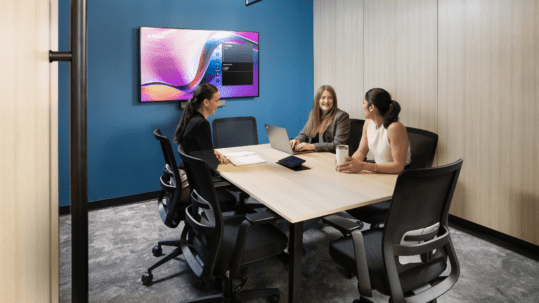While designing an office space requires a high level of creativity, data and analysis are just as important. Going beyond headcount, it is essential to consider everything from occupancy, workspace utilization, industry trends, and more. In the era of hybrid work, it can be tough to obtain accurate data as employees design their own workweek, and it can be challenging to see how the workplace is functioning visually. However, as the way we work has evolved, so has the technology capable of supplying companies with data. When implemented and administered correctly, data can be used to create an office environment that not only meets the needs of your business but also enhances and celebrates your unique company culture.
This article will define workplace data analytics, explain how data can support workplace design, and identify various methods for leaders to gather insightful data that can aid in the development of an engaging workplace.
What is workplace data analytics?
Workplace data analytics refers to the use of data to optimize the workforce. It is the process of collecting people and workspace analytics and examining those data sets to draw conclusions about the information they contain to enable organizations to make more-informed business decisions. Furthermore, data analytics enables leadership to understand its workforce and workspaces better. When companies obtain actual data about how the built environment is being used, it can help develop a future-proof and effective workplace that supports employees and business needs.
How data and design interconnect in the workplace
Companies utilize data to inform various decisions, from tactical business strategies to day-to-day operations. But have you considered its role in reshaping and improving office design and the overall experience being created for employees? Previously, businesses designed workplaces based on anecdotal information or items that benefited leadership rather than the larger employee pool. However, as the way we work has evolved, there is a new demand for an evidence-based approach to the workplace. Companies can use data to make intelligent decisions about the workspace experience that benefits all employees, not just a select few.
Making data-driven decisions regarding workplace design boils down to how well executives understand their employees’ behaviour and workplace preferences on a granular level. To do so, robust workforce analytics are required, which can be gathered through workplace analytic software and platforms designed to supply organizations with the data they need to augment their workplace.
Ways to collect workplace data
Integrating applicable technologies and datasets can aid the overall life cycle of data-informed workplace planning and design. Companies may acquire the essential data to improve the workplace in various ways. Here is a list of different approaches to gathering workplace data analytics:
- In-depth employee assessment: Gain a holistic perspective by delving into comprehensive employee assessments. Uncover preferences, needs, and pain points that guide workspace optimization.
- Desk booking applications: Seamlessly optimize office utilization with desk booking apps. By analyzing usage trends, you can create a dynamic environment that aligns with employee needs.
- Space occupancy sensors: Leverage the magic of technology with space occupancy sensors. These data-driven insights reveal usage patterns, allowing more intelligent space allocation and energy efficiency.
- Interviews: Connect directly with your team through interviews. Candid conversations offer firsthand perspectives, steering data analytics toward actionable improvements.
Pivvot Strategy: data-driven design
Pivvot Strategy is a bold, data-driven analytics software that transforms how leaders re-imagine spaces by prioritizing people. The software helps organizations clarify workstyle personas and provides data on how the workspace can better support your teams. Pivvot’s Workstyle Personas are developed through leadership alignment and company-wide assessments, informing three dashboards that help shape work style, space allocation, and economic decisions – providing you with the data you need to enhance your workplace. Combined with expert guidance, this software eliminates assumptions using impartial, data-driven, and people-powered computations.
Introducing Pivvot’s occupancy sensors
Design with confidence and build the spaces that your teams require the most.
“When companies invest in capturing an extensive and complete office data set, they can evaluate office occupancy and acquire analytical data for shared spaces, giving a more accurate picture to use when making critical business decisions.
Pivvot Strategy now offers workspace occupancy sensors that provide more granular information regarding the organization’s occupancy and utilization of workstations.
Pivvot’s wireless desk occupancy sensors make it possible to evaluate space more effectively. The discrete sensors offer insights into work habits and utilization by automatically and anonymously detecting if a desk or meeting room is occupied. To capture data accurately and rapidly, wireless desk occupancy sensors use a combination of temperature measurements and machine learning to determine if a workstation is occupied. The data captured through the sensors provide companies with information on how employees work and interact with the spaces available to them.






